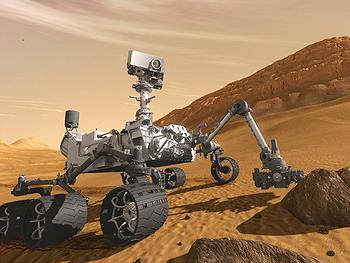
PASADENA, California, August 6, 2012 (ENS) – NASA’s Curiosity rover landed safely on Mars at 10:32 pm August 5, PDT, sparking joy and relief in hundreds of scientists with the U.S. National Aeronautics and Space Administration who contributed to the mission.
NASA Administrator Daniel Bolden blogged, “After an astounding 154-million-mile journey and a harrowing landing that demonstrated cutting-edge technology, Curiosity, the largest rover ever sent to another planet, is in place and ready to work.”

“This robotic laboratory will seek answers to one of humanity’s oldest questions as it investigates whether conditions have favored development of microbial life on the Red Planet,” wrote Bolden. “The mission is a critical planetary science mission – and a precursor to sending humans to the Red Planet in the 2030s, a goal set forth by President Obama.”
“Tonight, on the planet Mars, the United States of America made history,” President Obama said. “The successful landing of Curiosity – the most sophisticated roving laboratory ever to land on another planet – marks an unprecedented feat of technology that will stand as a point of national pride far into the future. It proves that even the longest of odds are no match for our unique blend of ingenuity and determination.”
President Obama used the landing to underline his vision “for a new partnership with American companies to send American astronauts into space on American spacecraft. That partnership will save taxpayer dollars while allowing NASA to do what it has always done best – push the very boundaries of human knowledge.”
The mission has cost an estimated $2.5 billion, which NASA officials said amounts to about $7 for every U.S. citizen.
The President said American “preeminence – not just in space, but here on Earth depends on continuing to invest wisely in the innovation, technology, and basic research that has always made our economy the envy of the world.”

During its nearly two-year mission, Curiosity will investigate whether Mars has ever offered conditions favorable for microbial life, including the chemical ingredients for life.
The Mars Science Laboratory spacecraft was launched from Cape Canaveral Air Force Station, Florida, on November 26, 2011.
To land on Mars, the spacecraft steered itself during the descent through Mars’ atmosphere with a series of S-curve maneuvers similar to those used by astronauts piloting NASA space shuttles.
During the three minutes before touchdown, the spacecraft slowed its descent with a parachute, then used retro rockets mounted around the rim of an upper stage. In the final seconds, the upper stage acted as a sky crane, lowering the upright one-ton rover on a tether to the surface.
Curiosity landed near the foot of a mountain three miles tall and 96 miles in diameter inside Gale Crater. To begin its two-year investigation, Curiosity is beaming black and white images of its surroundings back to Earth.

“Curiosity’s landing site is beginning to come into focus,” said John Grotzinger, project manager of NASA’s Mars Science Laboratory mission, at the California Institute of Technology.
“In the image, we are looking to the northwest. What you see on the horizon is the rim of Gale Crater. In the foreground, you can see a gravel field. The question is, where does this gravel come from? It is the first of what will be many scientific questions to come from our new home on Mars,” Grotzinger said.
While the image is twice as big in pixel size as the first images beamed down from the rover, they are only half the size of full-resolution Hazcam images.
During future mission operations, these images will be used by the mission’s navigators and rover drivers to plan the vehicle’s next drive. Other cameras aboard Curiosity, with color capability and much higher resolution, will send images back to Earth over the next several days.
Curiosity is about 10 feet long, about twice as long and five times as heavy as NASA’s twin Mars Exploration Rovers, Spirit and Opportunity, launched in 2003.
It inherited many design elements from them, including six-wheel drive, a rocker-bogie suspension system and cameras mounted on a mast to help the mission’s team on Earth select exploration targets and driving routes.
Unlike earlier rovers, Curiosity carries equipment to gather samples of rocks and soil, process them and distribute them to onboard test chambers inside analytical instruments.
The rover was designed, developed and assembled at the Jet Propulsion Laboratory, a division of the California Institute of Technology in Pasadena. The mission is managed by JPL for NASA’s Science Mission Directorate in Washington.
Scientists from Spain, Finland and Russia contributed to the Curiosity mission.
Click here to see more images from the Curiosity mission. Click here to view Curiosity videos.
Copyright Environment News Service (ENS) 2012. All rights reserved.
